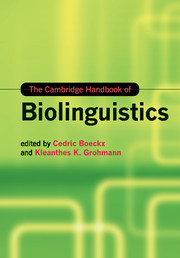
- Publisher:
- Cambridge University Press
- Online publication date:
- May 2013
- Print publication year:
- 2013
- Online ISBN:
- 9780511980435
- Collection:
- Cambridge Handbooks of Linguistics
- Subjects:
- Life Sciences, Evolutionary Biology, Evolution of Language, English Language and Linguistics: General Interest, Language and Linguistics

